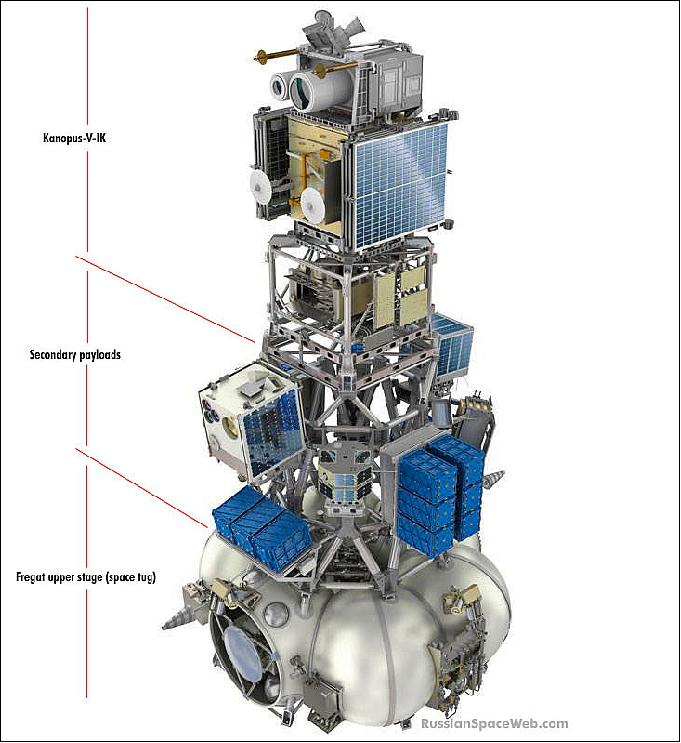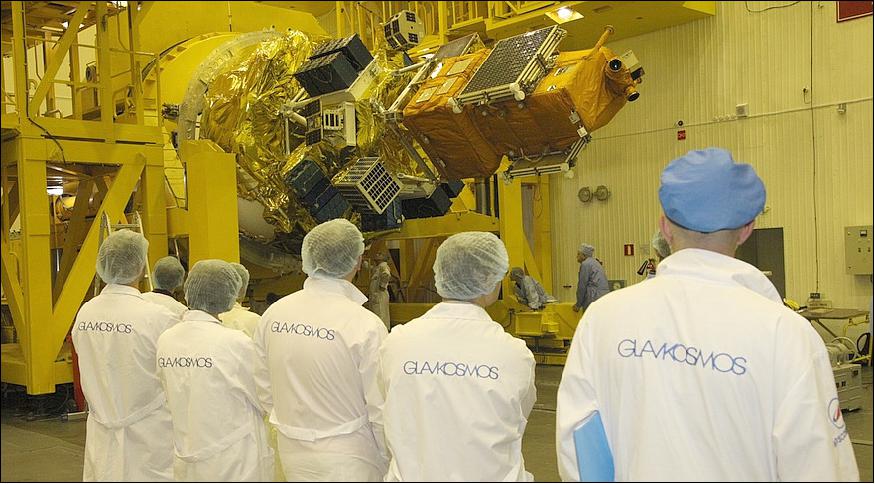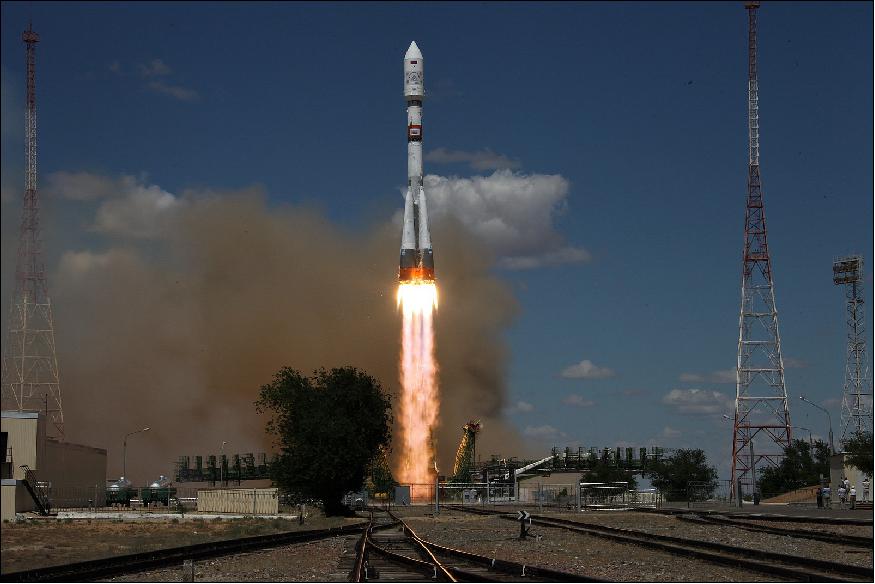Kanopus-V-IK 1 (Kanopus-Vulkan-Infra-Krasny-1)
EO
Ocean
Multi-purpose imagery (ocean)
Ocean imagery and water leaving spectral radiance
Quick facts
Overview
| Mission type | EO |
| Agency | ROSKOSMOS |
| Mission status | Operational (nominal) |
| Launch date | 14 Jul 2017 |
| Measurement domain | Ocean, Land |
| Measurement category | Multi-purpose imagery (ocean), Multi-purpose imagery (land), Surface temperature (land) |
| Measurement detailed | Ocean imagery and water leaving spectral radiance, Fire temperature, Active Fire Detection |
| Instruments | PSS, MSS |
| Instrument type | Imaging multi-spectral radiometers (vis/IR), High resolution optical imagers |
| CEOS EO Handbook | See Kanopus-V-IK 1 (Kanopus-Vulkan-Infra-Krasny-1) summary |
Kanopus-V-IK 1 (Kanopus-Vulkan-Infra-Krasny-1)
Launch Sensor Complement References
Kanopus-V-IK is a small Russian (Roscosmos) remote sensing satellite for Earth-observation purposes. Designed to be operational for up to five years, the spacecraft has an infrared capability for a primary purpose of detecting sources of fire as small as 5 m x 5 m on a 2,000 km swath of land. The satellite could also monitor other natural and man-made disasters, such as floods and chemical spillage. It could also be used to support agriculture and land usage, monitor shorelines and water conditions and search for natural resources (IK =Infra-Krasny, means "infrared" in Russian).
The satellite was originally built as Kanopus-V 2 by NPO VNIIEM, who subcontracted the avionics suite to SSTL. After modifications, it gained a new infrared capability for a primary purpose of detecting sources of fire.


The Kanopus-V-IK minisatellite uses the Kanopus bus, hosting two deployable solar arrays with an average power supply of 300 W. The spacecraft has a mass of ~473 kg and a design life of 5 years. The spacecraft is 3-axis stabilized.

Unfortunately, very little descriptive information is provided by the Russian side regarding the spacecraft as well as the sensor complement.

Launch
The Kanopus-V-IK satellite cluster mission for Roscosmos, along with many secondary payloads, was launched on July 14, 2017 (06:36:49 UTC, 09:36:49 Moscow time) on Soyuz-2.1a / Fregat-M vehicle from the Baikonur Cosmodrome in Kazakhstan. 2) 3) 4) 5)
Over the 8+ hour mission, a total of 72 commercial and university smallsats were injected into three unique orbits, with the subsequent de-orbiting of the booster.
Orbit: Injection of the primary payload and smallsats into 3 different orbits (the orbit of Kanopus-V-IK is ~ 500 km, the orbit of Flying Laptop is 600 km, the orbit of Dove 3U CubeSats is 475 km).
Secondary Payloads
In total, 72 secondary satellites will be launched on the Kanopus-V-IK mission, including spacecraft for four separate commercial remote sensing and weather constellations.
Glavkosmos, a subsidiary of Russian state space corporation Roscosmos, is seeking to become a larger provider of rideshare launch services for small satellites. In addition to this upcoming launch, Glavkosmos is planning to fly about 40 more small satellites on two Soyuz missions from the new Vostochny Cosmodrome in Russia's Far East region late this year, with additional launch opportunities planned for 2018 and beyond.
In addition, the German Orbital Systems company of Berlin, ECM Space Technologies GmbH, actively participates in the launch, by supplying a DCSM (Deployment Control and Separation Sequence Management) unit. Integration of two secondary satellites built in Germany, three from Russia and 12 from the USA. GlavKosmos subcontracted this task to ECM. 6)
• Forty-eight (48) Dove satellites (Flock 2k) of Planet will be launched into an SSO of 485 km altitude. 7) Planet of San Francisco is the biggest single customer for the upcoming launch. This "flock" of 48 satellites will go into a sun-synchronous orbit, but one slightly different from those of 88 similar satellites launched on an Indian Polar Satellite Launch Vehicle in February. Those satellites went into a sun-synchronous orbit that crosses the equator at 9:30 hours local time. The new satellites will launch into an orbit that crosses the equator at about 11:00 hours local time.
• Spire Global of San Francisco, which is deploying a fleet of CubeSats to collect GPS radio occultation and ship tracking data, has eight (8) of its Lemur CubeSats on this launch.
• GeoOptics of Pasadena, CA, is flying its three CICERO 6U CubeSats (CICERO-1, -2,- 3), designed to collect GPS radio occultation data to support weather forecasting.
• Flying Laptop, a minisatellite (120 kg) of IRS (Institute of Space Systems), University of Stuttgart, Germany.
• WNISAT- 1R (Weather News Inc. Satellite 1R), a microsatellite (43 kg) for north arctic routes and atmosphere monitoring. The project is started from the commercial objects between Weathernews and Axelspace, Japan. The object of the WNISAT-1R mission is monitoring of the Northern sea routes and of the CO2 content of the atmosphere. 8)
• NorSat-1 and NorSat-2 of the Norwegian Space Center, built by UTIAS/SFL (Canada) on GNB (Generic Nanosatellite Bus), each with a mass of 15 kg. The NORSAT-2 satellite will carry a next generation Automatic Identification System (AIS) receiver from Kongsberg Seatex, along with a VDE (VHF Data Exchange) payload that will enable two-way communication at higher data rates than possible with AIS. NorSat-1 (< 30 kg) carries three instruments: An AIS receiver, a Langmuir Probe Instrument, and CLARA (Compact Lightweight Absolute Radiometer), intended to observe total solar irradiation and variations over time.
• TechnoSat is a nanosatellite project (18 kg) of the Technical University of Berlin. Test of new nanosatellite components, including a camera, a new reaction wheel system, a star tracker, a transmitter, a fluid dynamic actuator, and commercial laser retro-reflectors.
• Corvus-BC 1 and Corvus-BC 2: Astro Digital, formerly known as Aquila Space, (formed from the core team of the former Dauria Space daughter Canopus Systems) developed the Corvus-BC Earth observation CubeSats (6U, 10 kg). The Landmapper-BC spacecraft, also known as Corvus-BC1 and Corvus-BC2, have color and infrared cameras for wide-area imaging.
• MKA-N 1, 2: Two Earth observation CubeSats (6U, 10 kg each) of Roskosmos, built by Dauria Aerospace.
• NanoACE, a technology demonstrator by Tyvak Nanosatellite Systems, Inc. (Irvine, CA) to validate the Endeavor suite technologies that will be used for future missions and is solely for the purpose of internal Tyvak development as an attitude control experiment. A 3U CubeSat (5.2 kg).
• Mayak: A Russian 3U CubeSat (4kg) developed by a group of young scientists named "Your sector of space" with support of the Moscow State University of Mechanical Engineering (MSUME). In orbit, the 3U CubeSat will deploy four triangular reflectors, 4 m2 each, which form a tetrahedral shape. The reflectors are made from metalized membrane with reflection coefficient of 95%. The reflector will provide a -10 optical magnitude at the beginning of the flight to allow for easy tracking. Mayak will be put into a tumbling motion over all axes, with at least 1 revolution per second.
• Iskra-MAI-85, a CubeSat of the Moscow Aviation Institute. 9)
• Ecuador-UTE-YuZGU, a CubeSat of the Kursk South-Western State University, Russia.

| 09:36:49 | launch vehicle lift-off; |
| 09:38:46 | 1st stage separation; |
| 09:41:36 | 2nd stage separation; |
| 09:41:38 | fairing jettison; |
| 09:45:37 | head module separation; |
| 09:45:42 – 09:52:18 | Fregat upper stage flight to a transfer orbit; |
| 10:35:01 – 10:36:27 | Fregat upper stage flight to the Kanopus-V-IK separation orbit; |
| 10:38:07 | Kanopus-V-IK separation (orbit i=97.44°; H = 522.5km; h = 478.6km); |
| 11:13:29 – 11:14:35 | Fregat upper stage flight to the second transfer orbit; |
| 12:01:43 – 12:05:03 | Phase 1. Separation of 5 smallsats (orbits i=97.61°; H = 601.5-600.1km; h = 600.0-590.1km); |
| 12:10:03 – 12:26:43 | Phase 2. Separation of 19 smallsats (orbits i=97.62-97.61°; H = 601.0-606.9km; h = 580.1-587.4km); |
| 12:51:49 – 12:53:15 | Fregat upper stage flight to the third transfer orbit; |
| 13:34:39 – 13:35:51 | Fregat upper stage flight to the separation orbit of a group of smallsats; |
| 17:18:23 – 17:41:17 | Separation of 48 smallsats (orbits i=97.00-97.01°; H = 485.0-477.4km; h = 482.2-450.5km); |
| 17:51:49 – 17:53:45 | Fregat upper stage flight to reentry orbit; |
| ~18:18:49 | Fregat upper stage reentry (altitude – 100 km), sinking in the Indian Ocean. |
Sensor Complement
To provide monitoring of the Earth's surface, the satellite is equipped with three instruments, including an imaging camera and the multi-channel radiometer operating in medium and far-infrared range of spectrum. The payload section, TsA, on the satellite also includes an onboard data system and a radio system for downlinking of information from scientific instruments, RLTsI-KV.
PSS (Panchromatic Imaging System)
Resolution (0.54-0.86 µm); spatial resolution: 2.1 m
Swath width: 23 km
MSS (Multispectral Imaging System)
Resolution (4 bands 0.46-0.84 µm); spatial resolution: 10.5 m
Swath width: 23 km
MSU-IK-SR (Multispectral Scanner Unit-IK-SR)
Resolution (2 bands, 3.5-4.5 µm, 8.4-9.4 µm), spatial resolution: 200 m
Swath width: 2000 km
References
1) Anatoly Zak, "Soyuz to launch a space-age 'Tower of Babel'," July 13, 2017, URL: http://www.russianspaceweb.com/kanopus-v-ik.html
2) "ROSCOSMOS: Soyuz-2.1a Launch Vehicle with KANOPUS-V-IK Satellite Successfully Lifts Off From Baikonur," Roscosmos, July 14, 2017 [web source no longer available]
3) Stephen Clark, "Soyuz rocket lifts off with 73 satellites," Spaceflight Now, July 14, 2017, URL: https://spaceflightnow.com/2017/07/14/soyuz-rideshare-launch/
4) Jeff Foust, "Soyuz set to launch 72 smallsats," Space News, July 7, 2017, URL: http://spacenews.com/soyuz-set-to-launch-72-smallsats/
5) "Russia's Soyuz-2.1 Set to Launch 71 Smallsats Later This Week," Satnews Daily, July 10, 2017, URL: http://www.satnews.com/story.php?number=704505558
6) "Launch campaign for „Soyuz": maiden flight for our DCSM unit," Orbital Systems, May 25, 2017, URL: https://web.archive.org/web/20170606075556/http://www.orbitalsystems.de/launch-campaign-for-soyuz-maiden-flight-for-our-dcsm-unit/
7) Leena Pivovarova, "48 Doves to Launch on a Soyuz Rocket," July 7, 2017, URL: https://www.planet.com/pulse/48-doves-to-launch-on-a-soyuz-rocket/
8) https://web.archive.org/web/20200926204435/https://www.axelspace.com/en/solution_/wnisat1r/
9) "Russia will launch into orbit 72 small satellites per launch," Russian Aviation, 15 June 2017, URL: https://www.ruaviation.com/news/2017/6/15/8955/?h
The information compiled and edited in this article was provided by Herbert J. Kramer from his documentation of: "Observation of the Earth and Its Environment: Survey of Missions and Sensors" (Springer Verlag) as well as many other sources after the publication of the 4th edition in 2002. - Comments and corrections to this article are always welcome for further updates (eoportal@symbios.space).